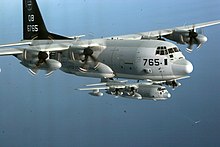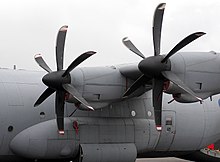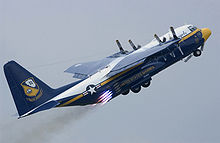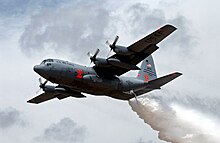Lockheed C-130 Hercules
The Lockheed C-130 Hercules is a four-engine turboprop cargo aircraft and the main tactical airlifter for many military forces worldwide. Over 40 models and variants of the Hercules serve with more than 50 nations. On December 2006 the C-130 was the third aircraft (after the English Electric Canberra in May 2001 and the B-52 Stratofortress in January 2005) to mark 50 years of continuous use with its original primary customer (in this case the United States Air Force).
Capable of short takeoffs and landings from unprepared runways, the C-130 was originally designed as a troop, medical evacuation and cargo transport aircraft. The versatile airframe has found uses in a variety of other roles, including as a gunship, and for airborne assault, search and rescue, scientific research support, weather reconnaissance, aerial refuelling and aerial firefighting. The Hercules family has the longest continuous production run of any military aircraft in history. During more than 50 years of service the family has participated in military, civilian and humanitarian aid operations.
Development
The Korean War, which began in June, 1950, showed that World War II-era transports—C-119 Flying Boxcars, C-47 Skytrains and C-46 Commandos—were inadequate for modern warfare. Thus, on February 2, 1951, the United States Air Force issued a General Operating Requirement (GOR) for a new transport to Boeing, Douglas, Fairchild, Lockheed, Martin Company, Chase Aircraft, Airlifts Inc, North American and Northrop. The new transport would have a capacity for 92 passengers or 64 paratroopers, a range of 1100 nautical miles, takeoff capability from short and unprepared strips, and the ability to fly with one engine stopped.
Fairchild, North American, Martin and Northrop declined to participate. The remaining five companies tendered a total of nine designs: Lockheed two, Boeing one, Chase three, Douglas three, Airlifts Inc one. The contest was a close affair between the lighter of the two Lockheed (preliminary project designation L-206) proposals and a four-turboprop Douglas design. The Lockheed design team was led by Willis Hawkins starting with a 130 page proposal for the Lockheed L-206 and another two-turboprop and heavier one.[1] Hall Hibbard, Lockheed vice president and chief engineer, saw the proposal and directed it to Kelly Johnson, who remarked when he saw the proposal, "If you sign that letter, you will destroy the Lockheed Company." Both Hibbard and Johnson signed the proposal and the company got the contract for the now designated Model 82 on July 2, 1951.[2]
First flight
The first flight of the YC-130 prototype was made on August 23, 1954 from the Lockheed plant in Burbank, California. The aircraft, serial number 53-3397, was the second prototype but the first of the two to fly. The YC-130 was piloted by Stanley Beltz and Roy Wimmer on its 61-minute flight to Edwards Air Force Base; Jack Real and Dick Stanton served as flight engineers. Kelly Johnson flew chase in a P2V Neptune.[3]
Production
After the two prototypes were completed, production moved to Marietta, Georgia, where more than 2,000 C-130s have been built.[4]
The initial production model, the C-130A, was powered by Allison T56 turboprops with three-blade propellers. Deliveries began in December of 1956, continuing until the introduction of the C-130B model in 1959. Some A models were re-designated C-130D after being equipped with skis and rockets for jet-assisted takeoff. The newer C-130B had ailerons with more boost — 3,000 versus 2,050 lbf/in² (21 versus 14 MPa) — as well as uprated engines and four-bladed propellers that were standard until the late 1990s. The performance gains over the C-130A gave the C-130B the reputation of being the design's 'sports car' model.
C-130E model
The extended range C-130E model entered service in 1962. The increased range was achieved by under wing 5,150 liter (1,360 US gallon) fuel tanks, (center-section) wing-mounted auxiliary fuel tanks and more powerful Allison T-56-A-7A turboprops. The E model also featured structural improvements, avionics upgrades and a higher gross weight.
The KC-130 tankers, originally C-130Fs procured for the US Marine Corps (USMC) in 1958 (under the designation GV-1) are equipped with a removable 13,626 liter (3600 US gallon) stainless steel fuel tank carried inside the cargo compartment. The two wing-mounted hose and drogue aerial refueling pods each transfer up to 19 liters per second (equivalent to 300 US gallons per minute) to two aircraft simultaneously, allowing for rapid cycle times of multiple-receiver aircraft formations, (a typical tanker formation of four aircraft in less than 30 minutes). The US Navy's C-130G has increased structural strength allowing higher gross weight operation.
C-130H model

The C-130H model has updated Allison T56-A-15 turboprops, a redesigned outer wing, updated avionics and other minor improvements. Later H models had a new, fatigue-life-improved, center wing that was retro-fitted to many earlier H-models. The H model remains in widespread use with the US Air Force (USAF) and many foreign air forces. Initial deliveries began in 1964 (to the RNZAF), remaining in production until 1996. An improved C-130H was introduced in 1974.
From 1992 to 1996 the C-130H was described as a C-130H3 by the USAF. The 3 denoting the third variation in design for the H series. Improvements included a partial glass cockpit (ADI and HSI instruments), a more capable APN-241 color radar, night vision device compatible instrument lighting and an improved electrical system using Bus Switching Units to provide 'clean' power to the more sensitive upgraded components.
C-130K models
The equivalent model for export to the UK is the C-130K, known by the Royal Air Force (RAF) as the Hercules C.1. The C-130H-30 (Hercules C.3 in RAF service) is a stretched version of the original Hercules, achieved by inserting a 100-inch (2.54 m) plug aft of the cockpit and an 80-inch (2.03 m) plug at the rear of the fuselage. A single C-130K was purchased by the Met Office for use by its Meteorological Research Flight. This aircraft was heavily modified (with its most prominent feature being the long red and white striped atmospheric probe on the nose) to the extent that it was given the designation W.2, to differentiate it from the ordinary C.1. This aircraft, named Snoopy, was withdrawn in 2001.
Later C-130 models & variants

The HC-130N & P are long range search and rescue variants used by the USAF Air Rescue Service. Equipped for deep deployment of pararescue men (PJs), survival equipment, and aerial refueling of combat rescue helicopters (see KC-130H), they are usually the on-scene command aircraft for combat SAR missions. Early versions were equipped with the Fulton surface-to-air recovery system, designed to pull a person off the ground using a wire strung from a helium balloon. The John Wayne movie The Green Berets features its use. The Fulton system was later removed when aerial refueling of helicopters proved safer and more versatile. The movie The Perfect Storm depicts a real life SAR mission involving aerial refueling by an HC-130.
The C-130R and C-130T are US Navy and USMC models, both equipped with underwing external fuel tanks. The C-130T is similar, but has numerous avionics improvements over the R model and is fully night-vision system compatible. In both models, USMC aircraft are equipped with Allison T-56-A-16 engines. The USMC versions are designated KC-130R or KC-130T when equipped with underwing refueling pods and pylons.
The RC-130 is a reconnaissance version. A single example is used by the Islamic Republic of Iran Air Force in support of maritime patrol operations.
Civilian use
The Lockheed L-100 (L-382) is a civilian variant, equivalent to a C-130E model without pylon tanks or military equipment. The L-100 also has 2 stretched versions: the L-100-20 has an 8.3 ft (2.5 m) fuselage stretch and the L-100-30 is stretched by 15 ft (4.6 m). The L-100 has not seen widespread use in the civilian market.
Next generation
In the 1970s Lockheed proposed a C-130 variant with turbofan engines rather than turboprops, but the US Air Force preferred the takeoff performance of the existing aircraft. In the 1980s the C-130 was intended to be replaced by the Advanced Medium STOL Transport project. However, the project was canceled and the C-130 has remained in production.
C-130J model


The C-130J Super Hercules is the newest version of the Hercules and the only model still produced. Externally similar to the classic Hercules in general appearance, the J model is a very different aircraft. These differences include new Rolls-Royce Allison AE2100 turboprops with six-bladed composite scimitar propellers, digital avionics (including Head-Up Displays (HUDs) for each pilot), reduced crew requirements (2 pilots — no navigator or flight engineer), increased reliability and up to 27% lower operating costs. The C-130J is also available in a standard-length or stretched -30 variant. Lockheed received the launch order for the J from the RAF, who ordered 25 aircraft, with first deliveries beginning in 1999 as Hercules C. Mk 4 (C-130J-30) and Hercules C. Mk 5 (C-130J).
The largest operator of the new model will be the USAF, who are ordering the aircraft in increasing numbers, although as of 2005 Congress announced C-130J acquisition would be dramatically cut. Current operators of the C-130J are the USAF, United States Marine Corps (KC-130J tanker), U.S. Air National Guard, US Coast Guard, Royal Air Force, Royal Australian Air Force, Danish Air Force and the Italian Air Force. Total procurement of C-130J aircraft has reached 186 orders as of December 2006.[5]
Lockheed has offered to lease four C-130J's to the German Luftwaffe, which has been awaiting a Transall replacement set for 2010 (the Airbus A400M). Apparently, the deal was rejected as too costly.[citation needed]
The Indian Air Force has submitted a request for the purchase of six C-130J aircraft. The sale is expected to be finalized by the middle of 2007.[6]
A purchase order was announced November 22, 2006 to replace the Canadian Forces CC-130E and H models with 17 new airlifters.[7] The C-130J and A400M are expected to be competing for the Canadian order. As of November 22, 2006 the Canadian government has un-officially awarded the contract to Lockheed-Martin to produce the C-130J, citing a lack of test-flights for comparative analysis and confidence that the A400M would be delivered on schedule.[8]
The Royal Norwegian Air Force has decided to purchase four C-130Js to reinforce their transport capacity when it was discovered that their forty year old C-130s are unservicable during a wing change.[9]
Operational use


The Hercules holds the record for the largest and heaviest aircraft to land on an aircraft carrier. In October and November 1963, a USMC KC-130F (BuNo 149798), made 21 unarrested landings and take-offs on the USS Forrestal at a number of different weights. The pilot, Lt. James Flatley III, was awarded the Distinguished Flying Cross for his participation. The tests were highly successful, but the idea was considered too risky for routine "Carrier Onboard Delivery" (COD) operations. Instead, the C-2 Greyhound was developed as a dedicated COD aircraft. (The Hercules used in the test, most recently in service with VMGR-352 until 2005, is now part of the collection at the National Museum of Naval Aviation at NAS Pensacola, Florida.)
While the C-130 is involved in cargo and resupply operations daily, it has been a part of some notable offensive operations:
- The MC-130 variant carries and deploys what are currently the world's largest conventional bombs, the BLU-82 "daisy cutter" and GBU-43/B Massive Ordnance Air Blast bomb. Daisy cutters were used during the Vietnam War to clear landing zones for helicopters and to eliminate minefields and have recently even been proposed for anti-personnel use. The weight and size of the weapons make it impossible or impractical to load them on conventional bombers.
- In the Indo-Pakistani War of 1965, the Pakistan Air Force modified/improvised several aircraft for use as heavy bombers, and attacks were made on enemy bridges and troop concentrations with some notable successes. No aircraft were lost in the operations, though one was slightly damaged.[10]
- It was also used in the 1976 Entebbe raid in which Israeli commando forces carried a surprise assault to rescue 103 passengers of an airliner hijacked by Palestinian and German terrorists at Entebbe Airport, Uganda. The rescue force — 200 soldiers, jeeps, and a black Mercedes-Benz (intended to resemble Ugandan Dictator Idi Amin's vehicle of state) — was flown 4,000 km from Israel to Entebbe by five Israeli Air Force (IAF) Hercules aircraft without mid-air refueling (on the way back, the planes refueled in Nairobi, Kenya).
- During the Falklands War of 1982, Argentine Air Force C-130s undertook highly dangerous, daily re-supply flights to the Argentine garrison on the Falkland Islands (Malvinas). Only one was lost during the war. Argentina also operated two KC-130s refuellers during the war, and these refueled the Skyhawk attack planes which sank the British frigate HMS Antelope. The British also used their C-130s to support their logistical operations.
- During the Gulf War of 1991, the C-130 Hercules was used operationally by the US Air Force, US Navy and US Marines, and the air forces of Australia, New Zealand, Saudi Arabia, South Korea and the UK.
- During the invasion of Afghanistan and in support of the International Security Assistance Force, the C-130 Hercules was used operationally by Australia, Belgium, Canada, France, Italy, the Netherlands, New Zealand, Norway, South Korea, Spain, the UK and the United States.
- During the 2003 invasion of Iraq, the C-130 Hercules was used operationally by Australia, the UK and the United States. After the initial invasion, C-130 operators as part of the Multinational force in Iraq used their C-130s to support their forces in Iraq.

A prominent C-130T aircraft is Fat Albert, the support aircraft for the US Navy Blue Angels flight demonstration team. Although Fat Albert supports a Navy squadron, it is operated by the US Marine Corps (USMC) and its crew consists solely of USMC personnel. At some air shows featuring the team, Fat Albert takes part, performing flyovers and sometimes demonstrating its jet-assisted takeoff (JATO) capabilities.
Operational losses
The C-130 is generally a highly reliable aircraft. The Royal Air Force recorded an accident rate of about one aircraft loss per 250,000 flying hours over the last forty years, making it one of the safest aircraft they operate (alongside Vickers VC10s and Lockheed Tristars with no flying losses).[11]
However, more than 15 percent of production has been lost, including 70 by the United States Air Force and the United States Marine Corps while serving in the war in Southeast Asia. By the nature of the Hercules' worldwide service, the pattern of losses provides an interesting barometer of the global hot spots over the past fifty years.[12]
Variants

Significant variants of the C-130 include:
- C-130A/B/E/F/G/H/J/T tactical airlfter
- AC-130A/E/H/U gunship
- C-130D/D-6 ski-equipped version for snow & ice operations US Air Force Air National Guard
- DC-130 and GC-130 drone control
- EC-130E Commando Solo Former US Air National Guard Psychological operations version.
- EC-130E Airborne Battlefield Command and Control Center (ABCCC)
- EC-130H Compass Call, electronic warfare and electronic attack.[13]
- EC-130J Commando Solo US Air National Guard Psychological operations version
- HC-130H/N/P special operations air-to-air refueling tanker, long-range surveillance, search and rescue
- JC-130 and NC-130 temporary and permanent conversion for flight test operations
- KC-130F/J/R/T United States Marine Corps aerial refueling tanker and tactical airlifter
- LC-130F/H/R US Air National Guard ski-equipped version for Arctic & Antarctic support operations. Formerly operated by the US Navy and National Science Foundation
- MC-130E/H/W Combat Talon I/II, Combat Spear (special operations)[14]
- MC-130P Combat Shadow (special operations)
- YMC-130H three modified for planned Iran hostage crisis rescue attempt under project Credible Sport
- PC-130 maritime patrol
- RC-130 reconnaissance
- SC-130 search and rescue
- TC-130 aircrew training
- VC-130 VIP transport
- WC-130A/E/H/J weather reconnaissance ("Hurricane Hunter") version for US Air Force Air Force Reserve Command
- CC-130 Hercules designation for Canadian Forces Hercules aircraft
- C-130K Hercules designation for Royal Air Force Hercules aircraft
- L-100 Civilian version, equivalent to the C-130E
- L-100-20 Civilian version, stretched 8.3 feet
- L-100-30 Civilian version, stretched 15 feet
Operators



Survivors
- AC-130A USAF 53-3129, c.n. 3001
- First production Hercules, modified to gunship configuration in November 1967, survived 37 mm AAA hit over South Vietnam in March 1973, repaired, and finally retired from the 711th Special Operations Squadron in 1995 for display at the Air Force Armament Museum, Eglin AFB, Florida. Named "The First Lady" since November 1970.
- AC-130A USAF 54-1623, c.n. 3010
- Modified to AC-130A by Ling-Temco-Vought in March 1968, operations in SEA, named "Ghost Rider", then with the 711th SOS, 1975-1997. Retired to Dobbins AFB, Georgia, April 1997, with three-blade props reinstalled, as gate guard. To eventual Lockheed museum at Marietta, Georgia.
- AC-130A USAF 54-1626, c.n. 3013
- Prototype AC-130A upgrade, operations in Southeast Asia with the 16th Special Operations Squadron, 1967-1972, then to JC-130A test configuration. To the National Museum of the United States Air Force, Dayton, Ohio as JC-130A in 1976. Back to AC-130A configuration in late 1990s.
- AC-130A USAF 54-1630, c.n. 3017
- Airlifter with 314 TCW, then to Air Force Missile Test Center, Hanscom Air Force Base, February 1960, then modified to JC-130A with various units. Back to C-130A, November 1967. Conversion by Ling-Temco-Vought to AC-130A, January 1968, ops by 16 SOS, named "Mors de Coelis", then "Azrael - Angel of Death". To 415 SOTS, Hurlburt Field, Florida, August 1971, then to 711 SOS, Duke Field, Florida, November 1975, still as "Azrael" until retirement to the National Museum of the United States Air Force September 29, 1995.
- AC-130A USAF 56-0509, c.n. 3117
- Airlifter with 314 TCW, 315 AD, 374 TCW; to Ling-Temco-Vought, August 1970, and modified to AC-130A. Operations with 16th Special Operations Squadron; damaged at An Loc, South Vietnam, 23 December 1972; named "Raids Kill 'Em Dead", October, 1974, to 711th Special Operations Squadron, July 1975, named "Ultimate End", April, 1994; assigned to Hurlburt Field, Florida, October, 1994, and retired to Air Commando display park, May, 1995.
- C-130A USAF 57-0453, c.n. 3160
- Various airlifter assignments from 1958 to 1991, last duty with 155th TAS, 164th TAG, Memphis International Airport, Tennessee, 1976-1991, named "Nite Train to Memphis"; to AMARC in December, 1991, then sent to Texas for modification into replica of C-130A-II 56-0528, shot down by Russian fighters over Soviet Yerevan, Armenia on September 2, 1958, while on ELINT mission with loss of all crew. Now displayed in National Vigilance Park, National Security Agency grounds, Fort George Meade, Maryland. Three-blade prop replaced later four-blade version.
- KC-130F USMC BuNo 149798, c.n. 3680
- Used in tests in October-November 1963 by the U.S. Navy for unarrested landings and take-offs from the carrier USS Forrestal, it remains the record holder for largest aircraft to operate from a carrier flight deck, and carried the name "Look Ma, No Hook" during the tests. Retired to the National Museum of Naval Aviation, NAS Pensacola, Florida in May, 2003.
- C-130G USMC BuNo 151891, c.n. 3878
- Modified to EC-130G, 1966, then testbed for EC-130Q in 1981. To TC-130G in May 1990 and assigned as Blue Angels support craft, serving as "Fat Albert Airlines" from 1991 to 2002. Retired to the National Museum of Naval Aviation at NAS Pensacola, Florida, November 2002.
- C-130H 460, c.n. 4566
- Operated by 4 Squadron Royal Saudi Air Force, December 1974, same January 1987. Burned on ground, air conditioner fire - in airfield corner at Jeddah, Saudi Arabia, December 1989. Restored for ground training by August 1993, same March 2002. At Riyadh Air Base Museum, November 2002, restored for ground display.
- C-130H USAF 74-1686, c.n. 4669
- Airlifter with the 463rd TAW; one of three C-130H airframes modified to YMC-130H for aborted rescue attempt of Iranian hostages, Operation Credible Sport, with rocket packages blistered onto fuselage in 1980, but these were removed after mission was cancelled. Subsequent duty with the 4950th Test Wing, then donated to the Robins AFB museum, Georgia, in March 1988.
Specifications (C-130H)

Data from The Aviation Zone[15]
General characteristics
- Crew: 4-6: at least 2 pilots,1 flight engineer (eliminated in the J variant, replaced by crew chief), and 1 loadmaster; additional loadmaster and navigator are usually part of the crew
- Capacity:
- 92 passengers or
- 64 airborne troops or
- 74 litter patients with 2 medical personnel
Performance
References
- ^ Rhodes, Jeff (2004). "Willis Hawkins and the Genesis of the Hercules". Code One Magazine. 19 (3). Retrieved 2006-08-22.
- ^ Boyne, Walter J. (1998). Beyond the Horizons: The Lockheed Story. New York: St. Martin's Press.
- ^ Dabney, Joseph E. (2004). "A Mating of the Jeep, the Truck, and the Airplane" (PDF). Excerpted from HERK: Hero of the Skies in Lockheed Martin Service News. 29 (2). Lockheed Martin Air Mobility Support: 3. Retrieved 2006-08-22.
{{cite journal}}: Italic or bold markup not allowed in:|journal=(help) - ^ Cite error: The named reference
afmwas invoked but never defined (see the help page). - ^ "News Breaks", Aviation Week & Space Technology, 18 December 2006.
- ^ Defence Security Cooperation Agency (News Release)
- ^ "Airlift Capability Project - Tactical". MERX website. Government of Canada. Retrieved 2006-08-22.
- ^ "Lockheed wins $4.9B contract: Tories quietly pick U.S. aerospace giant to replace Hercules". Ottawa Citizen.
{{cite web}}: Unknown parameter|accessmonthday=ignored (help); Unknown parameter|accessyear=ignored (|access-date=suggested) (help) - ^ Contract for new transport planes signed (Norwegian Defence Force website) Template:No icon
- ^ Saqib Shafi. "Pakistan Air Force - Yesterday and Today". Pakistan Military Consortium. PakDef Info. Retrieved 2006-08-21.
- ^ "Aircraft Air Accidents and Damage Rates". Defence Analytical Services Agency. Retrieved 2006-08-22.
- ^ "Lockheed C-130 Hercules". Aviation Safety Network. Flight Safety Foundation. 2004-11-13. Retrieved 2006-08-22.
{{cite web}}: Check date values in:|date=(help) - ^ USAF news release
- ^ Housman, Damian (2006-06-29). "Highly modified C-130 ready for war on terrorism". Air Force Link. United States Air Force. Retrieved 2006-08-22.
{{cite news}}: Check date values in:|date=(help) - ^ Neely, Mike (©2006). "Lockheed C-130 Hercules". Retrieved 2006-08-22.
{{cite web}}: Check date values in:|year=(help)CS1 maint: year (link)
External links
- C-130 USAF fact sheet
- C-130 US Navy fact file
- C-130G Aircraft Characteristics on Navy.mil
- C-130J Specification Book
- C-130 page on GlobalSecurity.org
- C-130 Hercules page on AviaMil.net
- Lockheed C-130 Hercules page on Aircraft.co.za
- Fatal Coast Guard Crashes
- C-130 crash landing footage
Related content
Related development
Aircraft of comparable role, configuration, and era
Related lists
